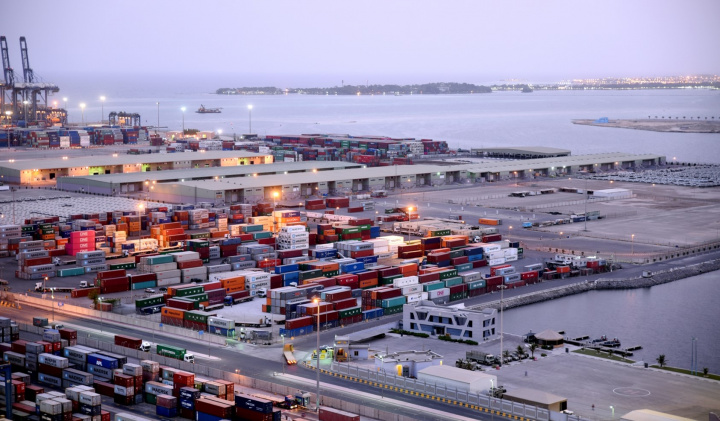Anyone who has tried to secure an Uber at a busy time of day will have experienced the ride-hailing app’s least appealing feature: surge pricing. Too many punters and too few available cars mean the cost of getting from A to B spikes. Something similar is currently afflicting the global shipping sector.
In the wake of Iran-aligned Houthi militants launching missiles at ships heading for the Suez Canal, freight rates more than doubled from around $1,200 per trip in 2023 to a January peak of $3,400. That’s according to an index compiled by shipping platform Freightos which tracks spot prices for 40-foot containers in 12 major trade lanes. Prices fell back in March and April, but since May they’ve rebounded to hit $4,500 – over triple their pre-crisis level.
On the face of it, the recent shipping cost spike is odd. The traditional peak season for exporters filling Christmas orders is some way off. And unlike the aftermath of the pandemic in 2021, when rates ballooned to nearly $12,000, there should be enough ships – in fact, the industry has struggled to absorb a record number of new vessels ordered in response to the Covid-era disruptions. In 2023, new deliveries of container ships added record capacity of 2 million 20-foot equivalent containers (TEU), according to AXSMarine analyst Jan Tiedemann. Another 3 million will be added this year and a further 2 million TEU in 2025.
Yet a host of countervailing forces are inflating rates. One is the cyclical rebound of the world economy. Global manufacturing output accelerated at its fastest year-on-year pace in 22 months in May, according to a Purchasing Managers’ Index produced by S&P Global. Combine that with major port strikes that have hit Germany and France, and could also affect the United States on the East Coast and Gulf of Mexico, and rates would have upward pressure even if two other unusual factors weren’t at play.
One of these unconventional drivers may be that exporters have been trying to speed up cargo deliveries to avoid what they fear is increasingly protectionist trade policy. In May U.S. President Joe Biden announced sharply raising tariffs on $18 billion of Chinese goods including electric vehicles, batteries, semiconductors, steel, solar cells and medical products.
With some of these expected to take effect as soon as August, this threat has triggered a race to front-load Chinese exports and stockpiling for importers, according to analysts at China Industrial Bank-affiliated CIB Research. The United States contributed the biggest growth among developed markets in China’s exports of goods in May, official data showed.
The trouble for exporters and importers is that geopolitical tensions may get worse. U.S. allies such as the European Union are already under pressure to expand the scope of their own tariffs on Chinese electric vehicles. If Donald Trump gets re-elected in November as the new U.S. president, he may be inclined to do more. After all, he slapped tariffs on $300 billion of Chinese goods during his last term.
The final piece of the puzzle is the Red Sea closure itself. Sailing around Africa via the Cape of Good Hope adds two weeks of travel in the case of Asian cargo destined for the Mediterranean and Europe, which means more ships are needed to maintain trade levels. With 1 million TEU of new ships already hitting the waters this year, the percentage of idle fleets still fell to 0.6%, per AXSMarine. That’s the lowest since around February 2022, and way below a normal healthy level of around 3%.
For shipping companies whose bottom line is closely correlated with the freight rates, this is all very handy. The higher their exposure to spot prices, the better. Shares of $2 billion Israeli shipping company Zim Integrated Shipping Services ZIM.N, which was among the first to divert from the Red Sea and which has about 65% of its contracts signed on spot rates, have risen over 170% since mid-December. Denmark’s Maersk only gained 15%, as its spot contract exposure is typically only about 35%. But given fixed contracts typically get renegotiated twice a year, and shippers frequently impose ad hoc surcharges, it’s unlikely to entirely miss out on the windfall.
It’s possible that the current demand-inflating noise surrounding tariffs, economic recoveries and port strikes fizzles out later this year. But more than six months after the Houthi attacks hit, shipping companies like Hapag-Lloyd HLAG.DE show no sign of wanting to return to the Suez. Freight rates for certain routes could rise to up to $9,000 in the next few months, according to Freightos estimates. When it comes to adhering to the balance of supply and demand, Ubers and ocean-going tankers are more similar than they might appear.
Global container rates have rebounded since May, rising past a January peak of $3,400 to reach around $4,500 as of late June, according to the Freightos Baltic Index.
U.S. President Joe Biden announced in May that he is sharply raising tariffs on $18 billion of Chinese imports, ranging from electric vehicles to solar cells, in a pre-election effort to protect U.S. jobs. In one of the biggest moves, Washington said it will quadruple the tariff on Chinese EVs to 100% this year.
Source: Hellenic Shipping News





